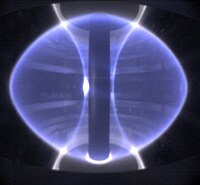
Photo from wikipedia
We perform a series of three-dimensional, magnetohydrodynamical simulations of star cluster formation including gravity, turbulence, magnetic fields, stellar radiative heating, and outflow feedback. We observe that the inclusion of protostellar… Click to show full abstract
We perform a series of three-dimensional, magnetohydrodynamical simulations of star cluster formation including gravity, turbulence, magnetic fields, stellar radiative heating, and outflow feedback. We observe that the inclusion of protostellar outflows (1) reduces the star formation rate by a factor of ∼2, (2) increases fragmentation, and (3) shifts the initial mass function (IMF) to lower masses by a factor of 2.0 ± 0.2, without significantly affecting the overall shape of the IMF. The form of the sink particle (protostellar objects) mass distribution obtained from our simulations matches the observational IMFs reasonably well. We also show that turbulence-based theoretical models of the IMF agree well with our simulation IMF in the high-mass and low-mass regime, but do not predict any brown dwarfs, whereas our simulations produce a considerable number of sub-stellar objects, which are produced by dynamical interactions (ejections). We find that these dynamical interactions also play a key role for the binary separation distribution and stellar kinematics in general. Our numerical model of star cluster formation also reproduces the observed mass dependence of multiplicity. Our multiplicity fraction estimates generally concur with the observational estimates for different spectral types. We further calculate the specific angular momentum of all the sink particles and find that the average value of $1.5 \times 10^{19}\, \mathrm{cm^2\, s^{-1}}$ is consistent with observational data. The specific angular momentum of our sink particles lies in the range typical of protostellar envelopes and binaries. We conclude that the IMF is controlled by a combination of gravity, turbulence, magnetic fields, radiation, and outflow feedback.
Journal Title: Monthly Notices of the Royal Astronomical Society
Year Published: 2021
Link to full text (if available)
Share on Social Media: Sign Up to like & get
recommendations!